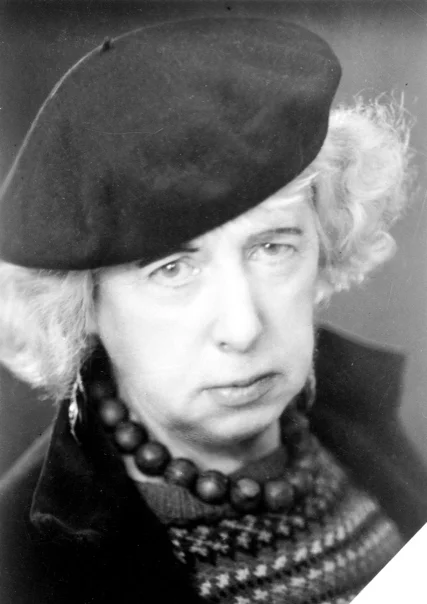A tramp on Dorset’s Jurassic coast unearthed the background to a much admired portrait of Frances Hodgkins.
Frances Hodgkins c. 1937
The photographer of the iconic photograph of Frances Hodgkins has been revealed as Joan Muspratt
—
Hodgkins lived in Worth Matravers from 1936 – 1939, and painted some of her most important oils in a studio converted from a garden shed in the village.
Linda Gill (ed.), Letters of Frances Hodgkins, 23 July 1937, Letter to Rée Gorer, Sea View Cottage, Worth Matravers, Dorset.
‘I started life here with a studio shed in the garden and one room – now I have spread over half the farmhouse & occupy quite a good little 3 roomed flat which I am decorating & simplifying to a labour saving bareness – with electric light & anthracite stove in the offing – to be installed before the winter. The house is a one time Vicarage, of the starkest kind, it never has had one single debonair touch – It overlooks the channel. The mornings are lovely and I want to paint even before I have finished breakfast’.
In June 2018, whilst tramping on the Jurassic coast near Worth Matravers in search of locations where Hodgkins had painted, Auckland Art Dealer Jonathan Gooderham, made an exciting discovery. After a hot day walking the coastline from Chapman’s Pool to St Aldhelm’s Head, Gooderham was walking back through Worth Matravers village when, in need of refreshment, he spotted the village fete and art exhibition in the Worth Matravers village hall.
He asked the attendant at the art exhibition if she had heard of the New Zealand artist Frances Hodgkins, and was told that the lady at the cake stall may know something. To his surprise, the lady on the sponge cake stall knew a friend who had often talked about Frances Hodgkins. This introduction led to Jessica Sutcliffe who had recently written a book about her mother, Helen Muspratt who had owned a photographic studio in nearby Swanage. In the late 1930’s her sister Joan, took over the studio and specialised in portraits. It was Joan Muspratt who had taken the iconic photograph of Frances wearing a beret and Fairisle jumper. The photograph had been published in her book Face: Shape and Angle, Helen Muspratt, Photographer by Jessica Sutcliffe (ISBN 978 1 5261 0084 9) and is reproduced above with the kind permission of Jessica Sutcliffe.
Joan Muspratt (Quetta, India 1908 – 1957 England) became well-known in Swanage and very much part of the local community. She photographed all the celebrations, carnivals and general happenings in the town. Her images of Purbeck’s wonderful coastline, ancient farmhouses, local quarrymen at work and members of the lifeboat crew provide a fascinating record of daily life at the time in a small seaside town and are still much valued. Many can be found at the local museum.
The single remaining studio copy of the photograph is fortunate to survive. The studio was extensively damaged by German bombing in 1942 and the majority of the studio’s early slides were destroyed.
Gooderham says, ‘It just shows that researching Frances Hodgkins is like the joining up the threads in a spider’s web. Head in the right direction and with a large helping of serendipity, it is amazing what can be unearthed’!
Jonathan Gooderham, a West Country man by birth, has a longstanding interest in the works of Frances Hodgkins and regularly travels around the West Country of England searching out spots where Frances Hodgkins lived and painted. In June 2019 Gooderham will be exhibiting fourteen newly discovered paintings by Hodgkins at his gallery in Parnell, Auckland. The exhibition, Frances Hodgkins A New Zealand Modernist, opens on Thursday 30 May 2019.
Chapmans Bay, Jurassic Coastline near Worth Matravers
Photo/Jonathan Gooderham
The Village Hall, Worth Matravers, June 2018
Photo/Jonathan Gooderham
ABOUT WORTH MATRAVERS
—
A lovely village in the Purbeck area of south Dorset, Worth Matravers was the location of the first radar station in Britain. Of much older construction is the late Saxon church of St Nicholas, which boasts a fine Norman chancel arch and interesting medieval carvings.
The settlement was known simply as 'Worth', meaning an enclosure, until the late 14th century. The 'Matravers' part of the name was added in honour of William Matravers, Constable of Corfe Castle.
The village pub is the popular Square and Compass, which began as a pair of 18th-century cottages. Around 1776 the cottages were converted into an alehouse called The Sloop. The name changed to the Square and Compass in 1830. During the period between the two World Wars, the pub was a gathering place for artists such as Augustus John. One unusual feature is a small museum inside the pub, with displays of local history and a large collection of geological samples including locally discovered fossils.
Other interesting buildings in the village include Dunshay Manor, a 17th-century house on the site of a medieval manor.




